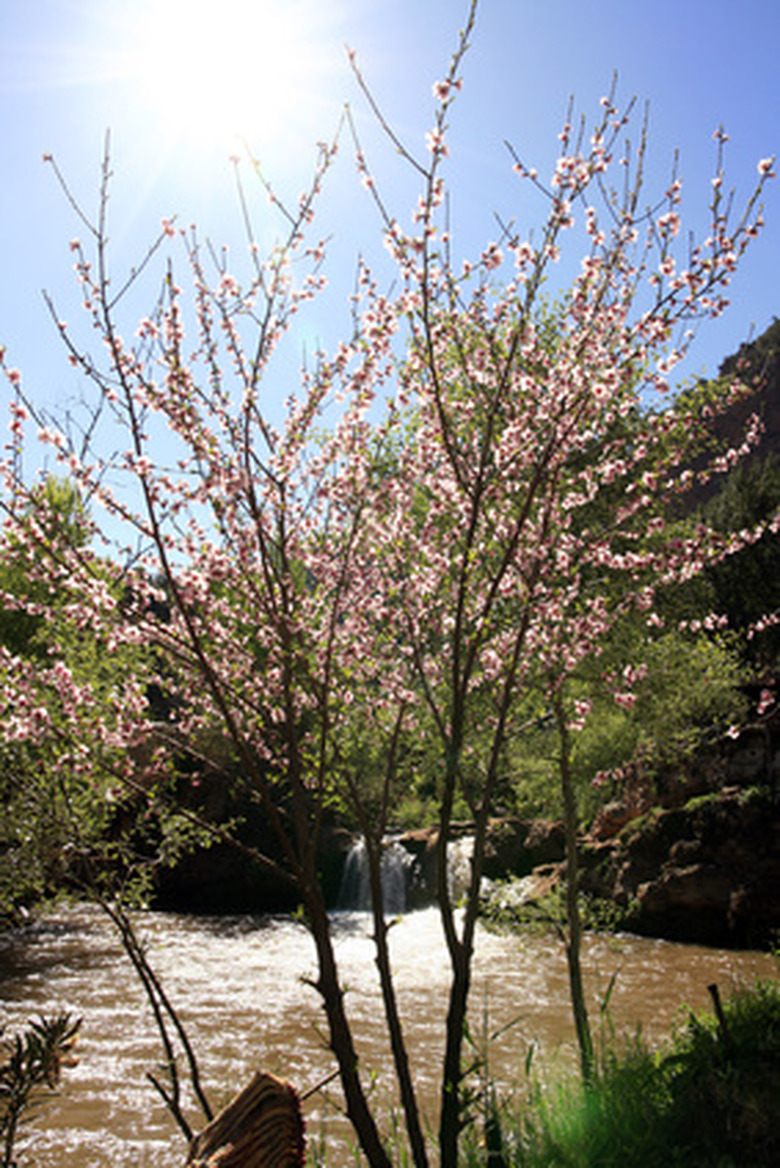Growing Almond Trees In Texas
Things Needed
- Well-drained soil
- Compost
- Organic materials
- Wheelbarrow
- Shovel
- Clippers or pruning shears
- Fertilizer
Almond trees are generally not suitable for growing in Texas because they bloom in early spring, when frost damages the blossoms or forming nuts, warns Texas A&M University. However, the varieties known as 'Mission' and 'Hall's Hardy' bloom later and might reward you with a crop of almonds in the fall. You can grow almond trees in large containers in Texas and then move them indoors in fall, where they will be safe until after your final spring frost occurs.
Step 1
Purchase a healthy, young tree that is either the 'Mission' or 'Hall's Hardy' variety. Before you plant it, cut the main central limb to make it about 2 feet tall, measuring from ground level. Using your clippers or shears, make your cut parallel to the ground. This will encourage the tree to grow into an open center configuration, which is recommended for certain fruit and nut trees. Also cut off all lateral branches
- Almond trees are generally not suitable for growing in Texas because they bloom in early spring, when frost damages the blossoms or forming nuts, warns Texas A&M University.
- This will encourage the tree to grow into an open center configuration, which is recommended for certain fruit and nut trees.
Step 2
Build a mound in a sunny planting area by piling up topsoil in an area about 8 feet across. Make your mound 6 to 12 inches high. Texas A&M University recommends that you prepare your planting area in winter and then plant almond trees in mid to late February. Dig a planting hole in the center of your mound that is twice as large as your almond tree's root system. Transfer the soil into a wheelbarrow and mix it with about 25 percent organic compost or other organic materials such as peat moss, fallen leaves, composted animal manure and/or grass clippings. Then fill the hole about half full with your amended soil.
Step 3
Remove your almond tree from its nursery pot and set it into its planting hole. Distribute the roots evenly around the base of the tree, and bury it to the top of its roots with the rest of the soil and compost mixture. Water it well by running a sprinkler near the base for 30 to 60 minutes. After planting, water your tree thoroughly every three weeks; but in hot weather water it once each week. Wait for the soil to dry out and do not over water your almond tree.
- Build a mound in a sunny planting area by piling up topsoil in an area about 8 feet across.
Step 4
Fertilize your almond tree for the first time after its leaves are fully developed. The first year of the tree's life, give it 1 cup of balanced fertilizer in April–a plant food having an N-P-K ratio of 10-10-10 or 16-16-16. In May, June and again in July feed it with 1 cup of 21-0-0 plant food, which has a very high nitrogen content. Give 2-year-old trees 2 cups of 21-0-0 fertilizer in March, April, May, June and July. Scatter granular fertilizer around the tree's canopy, but avoid contacting the trunk.
Step 5
Keep the area around your tree weed-free and clean up all fallen leaves and nuts to avoid insects and diseases.
Step 6
Prune Texas almond trees in winter every two to three years. Severe yearly pruning is not necessary. Your goal should be to maintain an open center, which will ensure the tree receives plenty of light at its central region. Always prune watersprouts or suckers, dead and broken branches and those that bump into other branches. Also cut limbs to achieve a balanced, symmetrical appearance. Texas A&M University advises against sealing pruning cuts with tar or other sealants.
- Fertilize your almond tree for the first time after its leaves are fully developed.
- Keep the area around your tree weed-free and clean up all fallen leaves and nuts to avoid insects and diseases.
Tip
If you plan to plant more than one almond tree, or if you are planting other trees in the same area, leave at least 20 feet between trees. The Hall’s Hardy and Mission almond varieties are compatible for pollination of the other’s flowers, which turn into the nuts you desire. For best results, plant one tree of each variety within 20 feet of each other.
